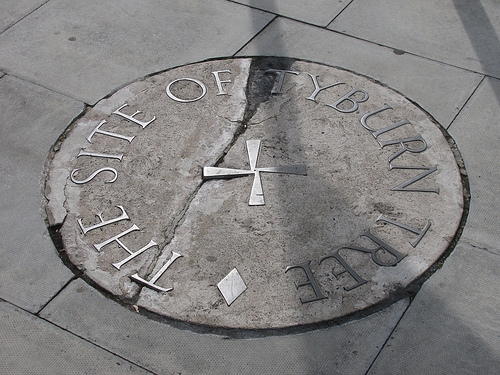Tyburn Gallows
There is no denying that London has something of a gruesome past, and you don’t have to look very far to find a part of it. Take for example the Tyburn Tree in Hyde Park in London. Throughout the length of the trees existence (it is no longer there) which covered a period of around 200 years, on every single Monday in every week of every one of those two hundred years, the men and women that had been condemned to death travelled through the city of London from Newgate Prison to the Hanging Tree at Tyburn. The tree was located at the junction of what we now recognise as the Edgware Road, Oxford Street and Park Lane, overlooking the beauty of Hyde Park. The majority of the people that were hanged here were commoners, but they were believed to total somewhere in the region of 60,000.

It was in 1196 that the first execution took place, with the last one being carried out here in 1783. In the beginning the condemned were hanged from the lower branches of the tree which stood on the banks of the Tyburn River, with a set of gallows being built on the site in 1220. A further gallows, known as the ‘triple tree’; which could be used to hang three people at once, was built here in 1571 only being removed in 1759 as it was found to be obstructing the public highway. It was replaced by a mobile gallows that was wheeled out for use when necessary.
About Tyburn
The River Tyburn has long since disappeared, becoming one of the city’s lost waterways, but at one time it flowed through Regent’s Park, down towards Piccadilly and then into the Thames. The prisoners would have been released from their shackles and driven through the city on the back of a cart, often they would be forced to sit upon their coffins as they rode. They would travel with the hangman and officers from the prison and the court to ensure that they did not escape. The journey covered three miles and could take anywhere up to three hours to complete.
The Executions
The gallows known as the Tyburn tree were immense. The three major posts were each eighteen feet high with the cross beams for each beam nine feet long. At full capacity it could accommodate twenty four prisoners. Execution at the hanging tree was slow and agonising. The condemned would be made to stand on the back of the wagon, with the noose around his or her neck, the horse would then be whipped and the wagon would pull away leaving the prisoners dangling where they died slowly of asphyxiation. This was all in the full gaze of the public. Executions were something of an event and crowds would line the whole of the route from Newgate through to the Gallows. If you look on one of the traffic islands in Marble Arch you will find a plaque stating that it marks the site of the original Tyburn Tree.

